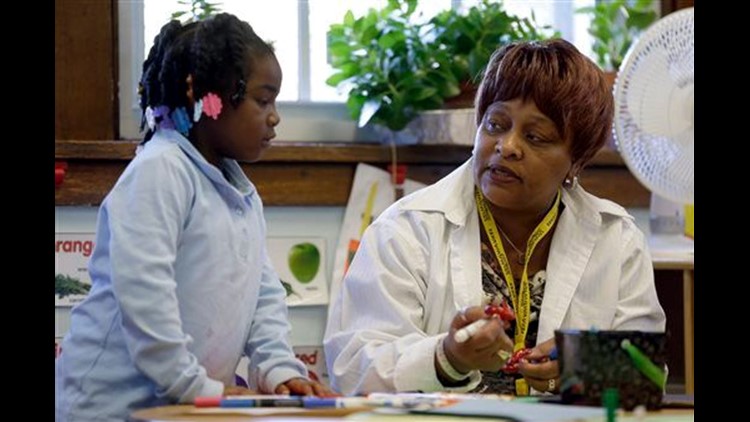ST. LOUIS (AP) — In days gone by, a knock on the door by a teacher or school official used to mean a child was in trouble. Not anymore, at least for parents and students at Clay Elementary School.
The urban public school is one of more than 30 in the St. Louis area that sends teachers on home visits several times a year. Unlike home visit programs that focus on truants and troublemakers, or efforts aimed exclusively at early childhood, the newer wave seeks to narrow the teacher-parent divide while providing glimpses at the factors that shape student learning before and after the school bells ring.
"I wish they had this when I had children in school," said Elmira Warren, a teacher's aide at Clay who has made home visits to her students and their parents. "I was fearful of what the teachers thought, and of not knowing enough."
The nonprofit HOME WORKS! program is modeled after one in Sacramento, Calif., that over the past decade has since spread to more than 300 schools in 13 states, with active programs in Washington, Denver, Seattle and St. Paul, Minn. Program leaders say participation leads to better attendance, higher test scores, greater parental involvement and fewer suspensions and expulsions, citing preliminary research of the newer program by the University of Missouri-St. Louis and a series of external reviews in Sacramento over the past decade. Participation is voluntary, and teachers are paid for their time.
"We've figured out a way for people to sit down outside the regular school and have the most important conversation that needs to happen," said Carrie Rose, executive director of the Parent Teacher Home Visit Project in the California capital.
The K-12 program began in 1999 as a faith-based community effort but quickly found support not only in the Sacramento school district but also with local teachers unions. The National Education Association has also endorsed teacher home visits, citing a "critical mass of research evidence" connecting high student achievement with involved parents.
No longer do parents only hear from teachers when there's a problem, or during brief school conferences that leave little time to go beyond the surface.
"She knows how much the teachers care when she sees them at her home," said Mark Brown, whose 6-year-old daughter Unafay attends Clay Elementary in north St. Louis.
A decade ago, Clay principal Donna Owens could barely attract 25 parents to meet their children's teachers even once at a school with more than 320 students, with one notable exception: the Halloween candy giveaway. A recent HOME WORKS! event at the 191-student school drew close to double that number of parents.
"Our parents feel much more comfortable coming to the school and being a part of it," Owens said.
The Missouri program, which began in St. Louis but now includes several schools 120 miles away in the college town of Columbia, follows a template common to the other efforts. Participating schools must agree to involve at least half of their teachers, and the educators work in pairs to ensure safety.
Program costs are often covered by foundation grants or borne by nonprofit supporters such as the Flamboyan Foundation, which paid for the program in the District of Columbia. Rose estimated the program cost at $10,000 annually for elementary schools, and $15,000 to $20,000 for high schools.
In Missouri, the first teacher visit comes in late summer, with the second session in the fall. While the follow-up session focuses on academics, the initial meeting is all about building a rapport, said Karen Kalish, a St. Louis philanthropist who founded HOME WORKS! in 2006.
"They go in as listeners and learners the first time," she said. "Just to get (parents) to start talking, to build their relationship."
Each session is followed by an invitation to continue the conversation at school over a communal meal. Busy parents who can't find the time or energy for such visits are told the school will also provide childcare and transportation if needed. Teachers must spend at least 30 minutes on the first visit and 45 minutes the second time, though often those minimums are exceeded.
"We want to do whatever we can to get them to come to school," Kalish said. "Something happens when parents see their kids' school for the first time."
Selling overworked teachers on the benefits isn't always easy. At Flynn Park Elementary in the St. Louis suburb of University City, teacher participation is down in the program's second year, said kindergarten teacher Debbie Kuster.
Some are simply too busy outside of school with their own families, she said. Others work second or even third jobs. And some teachers — Kuster included — prefer to keep their professional distance, she said.
"I'm uncomfortable going to the house," she said. "For certain people, they're more comfortable in their own territory."
Those who do connect with their students' families away from school describe a more collaborative approach to learning, an environment of mutual respect and appreciation rather than top-down communication.
"A lot of parents were willing to share with us," Warren said. "They saw we were parents ourselves. They let down their guard."
Fourth-grade teacher Cynthia Williams said her Clay Elementary Students learned to view her as more than just a two-dimensional authority figure.
"For some students, school and home are two different worlds," she said. "When you create that bridge, it becomes cohesive."
Kalish said the program also fosters parental accountability rather than a reliance on schools to essentially serve as surrogate parents for six or seven hours each day.
While the Missouri program and affiliated efforts nationwide remain relatively small, she hopes to build enough momentum to take the effort statewide, and envisions a broader effort that would elevate teacher home visits alongside such programs as Teach for America or Parents as Teachers, which focuses on increasing child-rearing skills through home visits for newborns and toddlers.
"We've got the secret sauce," Kalish said. "We know what works."
___
Online: HOME WORKS! www.teacherhomevisit.org
Parent Teacher Home Visit Project: www.pthvp.org
___
Follow Alan Scher Zagier on Twitter at http://twitter.com/azagier
Copyright 2013 The Associated Press. All rights reserved. This material may not be published, broadcast, rewritten or redistributed.



